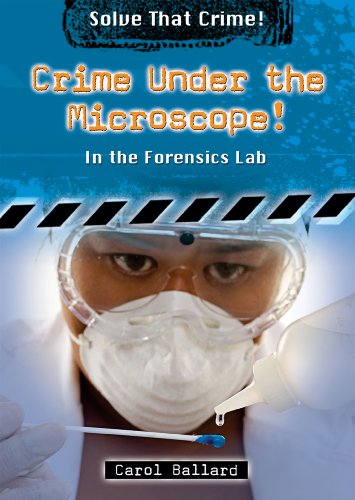-
Looking for Fingerprints
Melissa Langley Biegert
Library Binding (Capstone Press, July 1, 2009)A theft has occurred! The thief left behind few clues. Then a detective finds a fingerprint. Discover how police and forensic scientists use fingerprint evidence to catch criminals. S
S
-
Finding the Murder Weapon
Melissa Langley Biegert
Library Binding (Capstone Press, July 1, 2009)Murder! Where is the killer? Discover how finding the murder weapon can help police and forensic scientists put a killer in jail. T
T
-
Serial Killer File: The Doctor of Death Investigation
Mikaela Sitford
Library Binding (Bearport Pub Co Inc, July 31, 2007)Dramatic and riveting true stories written in a narrative nonfiction format show young readers how police officers, medical examiners, and private investigators use their crime-solving skills and forensic techniques to find clues that help them crack each case. S
S
-
Gathering Blood Evidence
Melissa Langley Biegert
Library Binding (Capstone Press, July 1, 2009)Detectives find a drop of blood at a crime scene. Will this clue help solve the crime? Discover how police and forensic scientists use blood evidence to catch criminals. T
T
-
The Unmarked Grave: Be a Forensic Anthropologist
Alix Wood
Library Binding (Gareth Stevens Publishing, Aug. 15, 2017)Explains what forensic anthropology is and follows professionals as they collect evidence and use science to solve a case.
-
Terrorist File: The Lockerbie Investigation
Amanda Howard
Library Binding (Bearport Pub Co Inc, July 31, 2007)Dramatic and riveting true stories written in a narrative nonfiction format show young readers how police officers, medical examiners, and private investigators use their crime-solving skills and forensic techniques to find clues that help them crack each case. S
S
-
Cause of Death
Michael Dahl, Barbara B. Rollins
Library Binding (Capstone Press, Jan. 1, 2004)Describes clues bodies leave behind about the cause of death, procedures for autopsies, and ways medical examiners form an opinion about how a death has occurred. T
T
-
Handwriting Evidence
Michael Martin
Library Binding (Capstone Press, Jan. 1, 2007)By the time they are in high school, every person has developed their own pattern of handwriting. Even when people try to disguise their writing, skilled investigators called forensic document examiners can see through the disguise to identify the true writer. Learn how document examiners help solve forgeries, kidnappings, and even murders. T
T
-
Fingerprint Evidence
Michael Dahl, Barbara B. Rollins
Library Binding (Capstone Press, Jan. 1, 2004)Describes the types and features of fingerprints and discusses the techniques used to take, develop, save, and compare fingerprints in order to solve crimes. T
T
-
Blood Evidence
Michael Dahl, Barbara B. Rollins
Library Binding (Capstone Press, Jan. 1, 2004)Describes how blood analysis is used to solve crimes, including the tests performed by lab technicians on samples to determine blood type and other characteristics, and finding, saving and interpreting blood evidence. T
T
-
Crime Under the Microscope!: In the Forensics Lab
Carol Ballard
Library Binding (Enslow Pub Inc, July 1, 2009)"Take a look at how forensics solves crimes in the laboratory"--Provided by publisher. Y
Y
-
Computer Evidence
Michael Dahl
Library Binding (Capstone Press, Sept. 1, 2004)Describes different types of computer crimes, including hackers sending viruses and worms, and how police investigators investigate and use computer evidence to track down suspects and solve cases. T
T